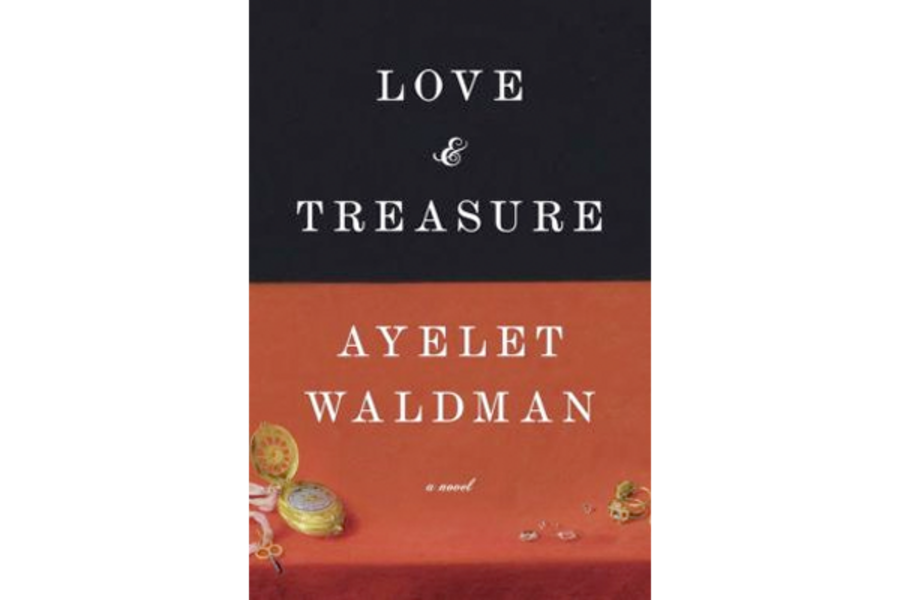Love & Treasure
Loading...
Like the peacock necklace that serves as its talisman, Ayelet Waldman’s Love & Treasure has more going on than first meets the eye.
The novel is a layered story that is a rare instance of a book becoming more involving the further in a reader goes. The cleverly constructed work spans 100 years of history, saving its most interesting section for the end.
This is an especially impressive achievement, since Waldman doesn’t exactly start small. She opens with the discovery of the Hungarian Gold Train by US soldiers in 1945.
“To help with the war effort,” a blustering Hungarian functionary offers as a euphemistic explanation for the boxcar upon boxcar loaded with household goods confronting the baffled American soldiers, “the valuables had been collected from the Jews of Hungary by the commissioner for Jewish Affairs.”
The teacups, camera equipment, books, watches, furs, carpets, candlesticks, microscopes, and bicycles, “constituted the wealth of the Jews of Hungary, 437,402 of whom had been deported to Auschwitz over the course of just 56 days almost exactly a year before,” Waldman writes.
Those belongings, and the murdered people who once used them in their daily lives, form the haunting center of “Love & Treasure.” In the first section, a Jewish lieutenant, Jack Wiseman, is charged with protecting the contents of the train. The Army doesn’t worry too much about returning the items to any of their owners who might have survived. In fact, the biggest threat of looting comes from Jack’s own top brass, who requisition everything from sheets and towels to china and crystal for their dinner parties.
Jack, an honorable man, is even more upset by all the unethical acquisitioning after he falls in love with Ilona, a Hungarian Jew who survived the camps and is searching for her sister. (Jack’s wooing of Ilona occasionally veers near melodrama, but Waldman’s endgame is a deeper one.)
When Ilona learns about what is happening to the property that belonged to her family and other Jews, she’s furious.
“It is not simple. I know that. It is all very complicated. But this is not complicated: my parents are dead. Don’t you think the US Army should give me back my bicycle?” she asks.
“Love & Treasure” avoids moral simplicity. Waldman includes painful episodes of survivors from the camps being massacred after returning to their homes. Others are judged as broken and corrupt by Jewish soldiers from Palestine, who nonetheless plan to use them as a propaganda tool toward the creation of Israel.
Despite his extreme discomfort, Jack ends up taking one thing from the train: a gold-filigree necklace that reminds him of Ilona.
“It bore the image, in vitreous enamel, of a peacock, a perfect gemstone staring from the tip of each painted feather,” Waldman writes.
That necklace becomes the linking object as “Love & Treasure” moves backward and forward through the 20th century, from 1913 Budapest, the novel’s most compelling section, to 2013, as Jack’s granddaughter Natalie tries to fulfill his last wish to find out who originally owned the necklace and return it to her heirs. It’s a device that’s been used by numerous writers, including Nicole Krauss, whose mammoth desk served as a similar function in “Great House.” And like the necklace, it’s what inside that ultimately gives the novel its lasting value.
Natalie is aided in her quest by a cynical art dealer, Amitai Shashos, who makes a tidy profit off stolen Holocaust artwork. Amitai thinks the necklace could help lead him to the work of a Hungarian artist, who died during the Holocaust. Natalie, who is perhaps less fascinating to the reader than Amitai, is at loose ends after a divorce and her decision to quit her law firm. Her search for the necklace’s real owners is mostly a grounded one involving tragedy, dead ends, and library archives, but there’s one madcap episode, when she impersonates a Hollywood location scout, that feels out of place.
The final section offers a portrait of several people whose belongings ended up on that train. It is written as a case study by Dr. Zobel, a psychiatrist treating Nina S., a beautiful young Hungarian radical whose father wants her “cured” so she will become a dutiful wife and mother. Poor Dr. Zobel keeps losing control of sessions and his narrative as the vibrant Nina and her friend, Gizella Weisz, scandalize the middle-aged doctor by attending rallies and daring to eat alone in cafes.
Waldman has great fun lampooning some of the more misogynistic beliefs of psychiatry’s early days as Dr. Zobel struggles with a growing belief that his patient might be completely sane. Waldman writes that she based Weisz, a Jewish little person who works as secretary for Hungary’s most famous suffragist, and her family on the Ovitzes from Transylvania, who came to the attention of Josef Mengele at Auschwitz.
Her last scene of the two young women is at a train station, a haunting reminder of what’s to come.
Yvonne Zipp is the Monitor's fiction critic.








